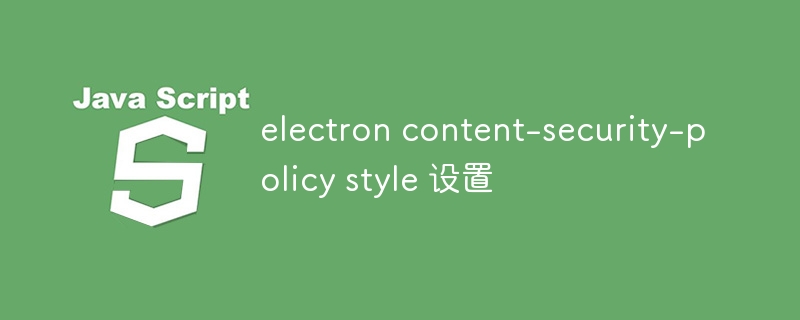Home >Web Front-end >JS Tutorial >electron content-security-policy style 设置
electron content-security-policy style 设置
- DDDOriginal
- 2024-08-15 13:46:381093browse
This article focuses on configuring the Content Security Policy (CSP) for styles in Electron, an application platform that allows developers to build cross-platform desktop applications using web technologies. The article discusses the use of the 'el

How can I configure the content security policy (CSP) for styles in Electron?
To configure the CSP for styles in Electron, you can use the electron.session.defaultSession.webRequest.onHeadersReceived event. This event is emitted when a request's headers are received, allowing you to modify the headers before they are sent to the server.electron.session.defaultSession.webRequest.onHeadersReceived event. This event is emitted when a request's headers are received, allowing you to modify the headers before they are sent to the server.
To add a CSP header to a request, you can use the setHeader method on the responseHeaders object. For example, the following code adds a CSP header to all requests:
<code class="typescript">electron.session.defaultSession.webRequest.onHeadersReceived((details, callback) => {
details.responseHeaders['Content-Security-Policy'] = 'default-src \'self\'; style-src \'self\' https://unpkg.com; img-src \'self\' https://unpkg.com https://example.com;'
callback({responseHeaders: details.responseHeaders});
});</code>
What are the best practices for setting up a CSP for styles in an Electron application?
When setting up a CSP for styles in an Electron application, there are a few best practices to follow:
- Use a default-src directive to allow all requests from the same origin. This will ensure that all of your application's styles are loaded.
- Use a style-src directive to specify which origins are allowed to load styles. This will help to prevent cross-site scripting attacks.
- Use a nonce to prevent inline styles from being executed. A nonce is a random value that is generated on the server and included in the CSP header. This helps to ensure that only styles that are loaded from trusted sources can be executed.
Which browser sources are supported by Electron's CSP for styles?
Electron's CSP for styles supports the following browser sources:
-
'self': This source represents the application's own origin. -
'unsafe-inline': This source allows inline styles to be executed. -
'unsafe-eval': This source allows inline scripts to be executed. 'none'To add a CSP header to a request, you can use the
setHeader method on the responseHeaders object. For example, the following code adds a CSP header to all requests:- Use a default-src directive to allow all requests from the same origin. This will ensure that all of your application's styles are loaded.🎜
- Use a style-src directive to specify which origins are allowed to load styles. This will help to prevent cross-site scripting attacks.🎜
-
Use a nonce to prevent inline styles from being executed. A nonce is a random value that is generated on the server and included in the CSP header. This helps to ensure that only styles that are loaded from trusted sources can be executed.🎜🎜🎜Which browser sources are supported by Electron's CSP for styles?🎜🎜Electron's CSP for styles supports the following browser sources:🎜
-
'self': This source represents the application's own origin.🎜 -
'unsafe-inline': This source allows inline styles to be executed.🎜 -
'unsafe-eval': This source allows inline scripts to be executed.🎜 -
'none': This source does not allow any resources to be loaded.🎜🎜
-
The above is the detailed content of electron content-security-policy style 设置. For more information, please follow other related articles on the PHP Chinese website!
Related articles
See more- An in-depth analysis of the Bootstrap list group component
- Detailed explanation of JavaScript function currying
- Complete example of JS password generation and strength detection (with demo source code download)
- Angularjs integrates WeChat UI (weui)
- How to quickly switch between Traditional Chinese and Simplified Chinese with JavaScript and the trick for websites to support switching between Simplified and Traditional Chinese_javascript skills

